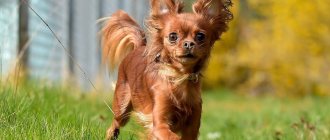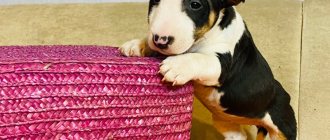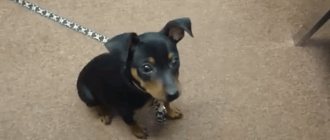On our website you can find a lot of advertisements for Dobermann puppies for sale. These can be private individuals who distribute offspring from their pets, as well as fairly well-known nurseries that can offer dogs from well-known manufacturers if they have all the relevant documentation. If you need to buy a Doberman puppy, read this article carefully. In it we will indicate the main points that you need to pay attention to when choosing a dog of this breed, which will be subject to certain requirements in the future. So, how to choose the right Doberman puppy?
Where is the best place to buy a puppy?
The first thing that anyone planning to buy a Doberman puppy needs to understand is that it is better not to take a dog from someone else or from a bird market. Transactions of this kind always carry a certain risk. The dog may turn out to be sick, not purebred, or not at all related to Dobermans. In addition, sellers of this kind will not be able to provide any documents for the puppy, will not allow you to meet its parents and will not show you the pedigree. It is especially dangerous that people who sell puppies at the poultry market almost never vaccinate their animals.
Advice! It is better to make inquiries in advance about the place you are going to go to buy a Doberman puppy. You need to take with you a person who is well versed in breeding dogs.
The fact that the chosen nursery is good will be noticeable from the first minutes of your stay there. A caring breeder always monitors the cleanliness of bedding and enclosures, and the dogs themselves are well-groomed and always healthy. You can ask him how to feed the puppy, how to care for him and what problems there may be with further education and training.
Conclusion
A puppy that has passed such a selection and has not shown fear, uncertainty, phlegmatism, or shown a posture of submissiveness, with good socialization and quality training, will be a reliable friend and a devoted guard.
Similar articles:
- How to choose real wine: tips from a sommelier
- How to choose the right mini Chihuahua when buying
- Which ozonizer to choose for an apartment: comparison of characteristics
- How to choose a personal fitness trainer at the gym
- How to choose the right cast iron battery: rating of popular models
The following two tabs change content below.
- Bio
Editor: Denis Nazarov
Position : editor-in-chief. About me : Generalist specialist. Experience as an editor and author of articles as a journalist for more than 12 years. He graduated from the Faculty of Philology of the Belarusian State University (Department of Russian Language and Literature) and received a diploma in the specialty “Philology. Teacher of Russian language and literature."
Articles from the author: Denis Nazarov (all articles)
- How to choose a good hand expander: comparison of models - 12/01/2020
- How to choose a gaming wheel: with or without pedals - 12/01/2020
- How to choose a gaming chair for your computer: tips - 12/01/2020
Breed classes
Once the kennel has been selected, you need to decide for what purposes the dog will be used. There are three main classes of breed that determine the purpose and, accordingly, the price:
- "Pet class." Such puppies are usually sold at half price, since they have a certain defect in appearance. They are in good health, but due to unusual coat color, eye color or malocclusion, they will not be able to take part in competitions or be used for breeding. Pet-class dogs are bought by those who simply want to buy a pet for their home and soul.
- Breeding class. Puppies from this category are considered to fully comply with breed standards. They are used for breeding and are allowed to participate in competitions and exhibitions. You won’t be able to purchase a “breed-class” individual at a discount.
- "Show class" “Show” puppies have a pedigree and exterior that is always ideal and impeccable. The winners at exhibitions will be representatives of the “show” class. The price for such dogs is the highest.
Important! Belonging to one class or another is determined no earlier than the puppy is 1.5 months old. It is not advisable to make an assessment earlier.
Training at 2 months. Upbringing
At 2 months old, your Doberman puppy is still at home, in quarantine after the first vaccinations, and he is not yet allowed to go for walks. Therefore, it’s time to start raising a puppy in the home conditions that are already familiar to him.
Toilet training
The first step is teaching the puppy to go to the toilet in a diaper . You should not rush to teach going to the toilet directly outside, bypassing this stage, because puppies are not physiologically ready for walking twice a day. This ability is developed in Doberman puppies no earlier than 6 months, and in some up to 1 year.
It should be remembered that any learning is a rather complex thing and, seeing the first positive results, you should not think that your puppy has already understood everything, but you should continue training according to the method, so that after a while you do not have to start all over again.
Collar and leash training
The second important point will be to accustom the puppy to a collar and leash . Yes, yes, this should be done at home, so that by the time the puppy goes outside for the first time, wearing a collar will not be additional stress for him, but is already a familiar thing, and he can start exploring the world around him, rather than trying to get rid of an unknown object.
What to allow a puppy and what not
The third point, which causes the greatest difficulty for new puppy owners, will be determining the puppy’s boundaries of what is permitted. Often, many novice dog owners think that the unwanted behavior of a Doberman puppy will “go away on its own, outgrow it.” But, unfortunately, the behavior that is allowed for a puppy will be taken for granted later by an adult dog.
.
Any unwanted behavior in a puppy WILL NOT go away on its own, but will only become stronger over time.
Therefore, it is necessary to start defining the puppy’s boundaries of what is permitted now. You will need:
- Teach to play only with your toys, and not with your things;
- Explain that you cannot bite your hands even in a game;
- Establish the correct daily routine, establishing the rule that in the morning you need to sleep and not wake you up;
- Stop chewing furniture, clothes, walls and baseboards;
- Teach to stay home alone, knowing that your absence is not a reason to bark or howl.
IT IS EXTREMELY IMPORTANT TO KNOW: constant and excessive punishments that follow almost every action of the puppy have a detrimental effect on his fragile psyche and can lead to the Doberman puppy growing up cowardly and embittered. For normal natural development, a puppy must have the opportunity to explore the world around him, which is currently limited to your apartment or house.
Introduction to Basic Commands
Already now you should begin to familiarize yourself with the initial obedience commands in a light playful form, while focusing on rewards for execution, because the puppy’s psyche is still quite plastic and excessive severity and exactingness can lead to the puppy being intimidated and cowardly. Therefore, it is necessary, first of all, to try to interest the puppy by offering him a toy or treat, and sometimes just praise.
What should a puppy look like?
When examining the babies presented for selection, you need to pay attention not only to their appearance, but also to the condition in which they are. A healthy Doberman will never have:
- light-colored eyes;
- white spots on the coat;
- crooked front and hind legs;
- underdeveloped skeleton;
- incorrect bite.
Healthy puppies have good immunity and excellent heredity. They have a shiny coat without bald spots with bright and clearly defined tan. The eye color is expressive and characteristic of the breed.
Important! Babies must be moderately well-fed, weight must be at least 3 and no more than 5 kg.
Often, breeders give all their puppies, even before they are sold, vaccinations that protect animals from many dangerous diseases. Vaccination can also be carried out immediately after purchasing the baby. Voluntarily refusing vaccination without first consulting a veterinarian is a big risk. The likelihood that a baby walking on the street will not pick up something dangerous that vaccination would protect him from is negligible.
Dobermans' attitude towards children
The slightly intimidating appearance of Dobermans hides an affectionate and loving character underneath. The peculiarity of the breed is sociality; communication with the owners is important for these dogs. Thanks to their intellectual abilities and strong-willed character, Dobermans become full-fledged members of the family.
Dobermans' attitude towards children:
- goodwill - the pet will happily accept the appearance of a new family member, will love the child as much as the owner;
- tenderness - Dobermans quickly become attached to children, constantly play active games with them without causing harm;
- understanding - dogs feel the insecurity and weakness of children, so they try to protect them from the dangers of the outside world;
- patience – pets can endure being rolled on their back, grabbed by the ears and tail, and hugged by children for a long time.
Important! It should be remembered that Dobermans have a limit to their patience. Severe pain will force dogs to growl or snap, so it is worth explaining to children that they should not grab or pull their pet for a long time.
Love and a friendly attitude allow you to leave your pets alone with the child. The pet will not harm a family member. However, the dog may perceive loud conversations, crying and sudden movements when playing with adults or other people's children as a threat to the owner's child. In this case, the pet will begin to show aggression, barking and growling as a sign of protection. Therefore, it is not recommended to leave Dobermans with strangers.
For a child, a Doberman is a good companion, but only if the pet is raised correctly. If you do not train, the dog will behave unpredictably.
Origin
The Dobermann was bred by tax collector Louis Dobermann in 1860. Due to his line of work, Louis often visited criminal areas, and therefore decided to breed a breed that could protect the owner. As a result of crossing a Rottweiler, a Pinscher, a Great Dane and a German Shepherd, this graceful and beautiful dog was obtained. After about 30 years, a new round of the breed appeared - the mini Doberman, they were used mainly for hunting.
Care and maintenance
The Doberman Pinscher is suitable for keeping in a private house or apartment. This dog cannot be kept on a chain: it needs communication with its owner. An animal living in isolation becomes aggressive and difficult to control. Needs regular long walks and a variety of activities. Loves agility training and outdoor games.
The Doberman is a short-haired breed, so it does not require daily brushing. It is enough to brush your dog once a week with a rubber mitt. Bathe her only if she is seriously soiled. The rest of the time, wipe with a damp towel.
Dandruff often forms in the area where the collar comes into contact with the fur. To avoid its occurrence, it is recommended to add 1 tbsp to the Doberman's diet. l. vegetable oil.
The ears are examined 2 times a week, cleaned as needed (at least once a month). For cleaning, use a cotton pad soaked in warm water or a special lotion. Cotton swabs can injure the ear. Only the outer part of the ear can be cleaned. Nails are trimmed monthly. In dogs that are regularly outdoors, they wear off on their own. Eyes are rubbed as needed. A cotton pad is moistened with warm water or chamomile infusion. After a walk, it is recommended to inspect the paw pads for cracks and damage.
Dobermans often develop blisters between their toes. This can lead to inflammation.
The first vaccinations are given at the age of 8-10 weeks. The next ones will be in 21-28 days. At 12 months, revaccination is carried out. After that, vaccinations are repeated once a year.
Feeding
The Doberman can be fed both home-cooked meals and high-quality dry food. A diet of natural products should include:
- lean beef;
- offal (udder, heart, tripe, lungs, liver, kidneys);
- cottage cheese, kefir, yogurt;
- raw eggs or omelet;
- sea fish (boiled, boneless);
- rolled oats steamed with meat broth;
- dry bread in small quantities;
- vegetables (except potatoes and legumes);
- garlic (1 clove per week);
- greens (nettle, dandelion leaves, parsley salad);
- vegetable oil, sour cream (as salad dressing);
- bran.
The daily amount of meat is 500 g. By-products are boiled until fully cooked, the meat is served raw or scalded with boiling water. It is preferable to mix a raw egg into porridge. One egg per week is enough for an adult dog. Sea fish is offered 3 times a week. River is a carrier of tapeworms and worms.
It is strictly forbidden to give your dog bird bones. They have a tubular structure and injure teeth, gums and esophagus.
List of prohibited products:
- corn, semolina, pearl barley, barley cereals;
- River fish;
- fatty meat (pork);
- legumes and potatoes;
- tubular bird bones;
- sweet;
- fat;
- roast;
- smoked;
- salty.
Natural feeding should be accompanied by taking a vitamin-mineral complex.
If the owner cares about the health of the pet, he will feed him premium and super premium dry food. Cheap brands, at best, do not bring any benefit, at worst, they cause severe poisoning and urolithiasis. Economy class food contains fragrances and flavor enhancers, as well as allergenic fillers.
List of quality feeds:
- Acana;
- Go Natural;
- Now Fresh;
- Grandorf;
- Applaws;
- Orijen;
- CarniLove;
- Farmina N&D;
- Savarra;
Drying causes extreme thirst, so the dog must have constant access to clean water.
The average serving size depends on the weight of the animal.
Diseases and life expectancy
Doberman Pinschers are known for their relatively good health. At the same time, their breed diseases are varied and form a frightening list:
- dysplasia of the hip and elbow joints;
- volvulus;
- compression of the cervical vertebrae;
- vitiligo;
- cataract;
- diabetes;
- baldness;
- hypothyroidism;
- melanoma;
- cataract;
- fibrosarcoma;
- von Willebrand disease;
- cutaneous histiocytoma.
Average life expectancy: 12-15 years.











